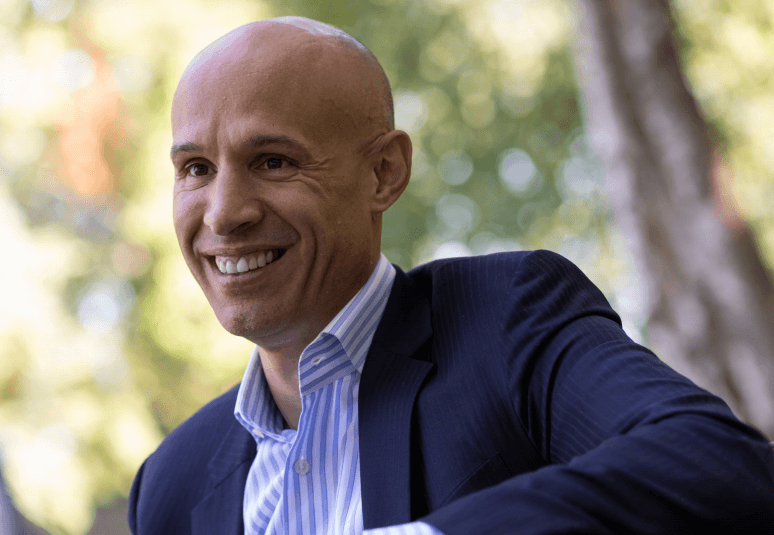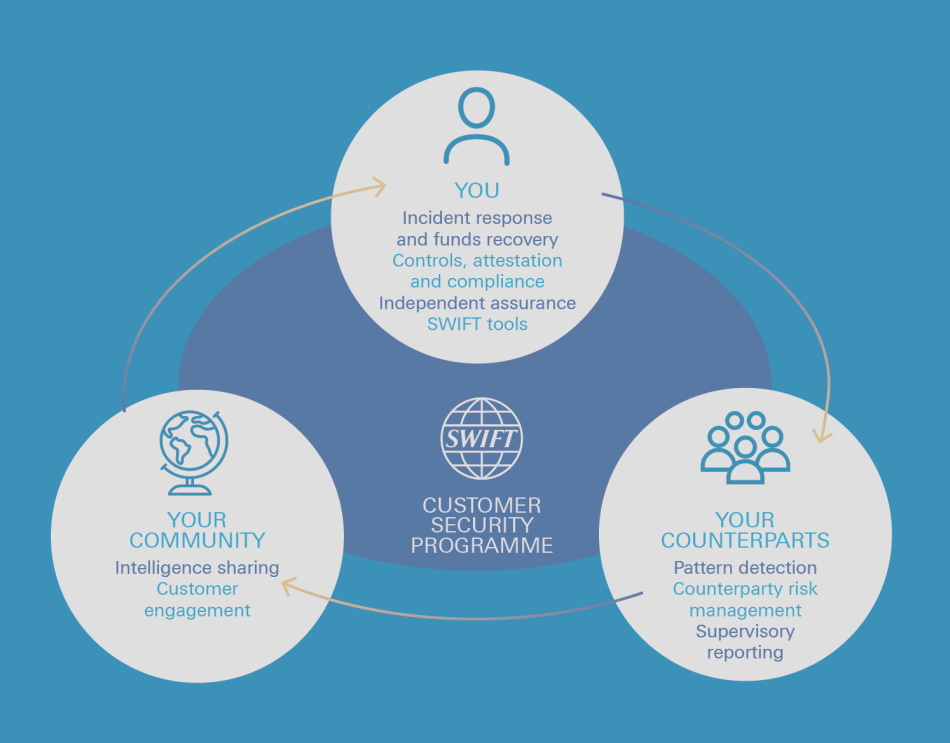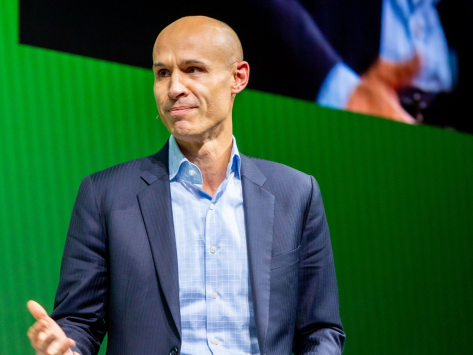September 2020
How can you connect four billion accounts across the world in an instant? That is the bold vision of SWIFT’s CEO, Javier Pérez-Tasso. Clarissa Dann talks to him about the responsibilities vested in a cooperative founded to create mutual benefit for the financial community and why a virtual Sibos for 2020 will keep the global financial community engaged
When Javier Pérez-Tasso took up his role as SWIFT’s top executive on 1 July 2019, little did he know that just months later the world would be plunged into the first recession triggered by a pandemic and the deepest economic contraction in decades.
Covid-19 has tested the operational resilience of many an international organisation, but how did what is effectively the banking sector’s circulatory system manage? And what effect has the pandemic had on its forward planning? “We have done everything to keep our vital services running smoothly for our customers and support them as they have navigated incredible circumstances,” explains Pérez-Tasso. “We have done so while prioritising, first and foremost, the health and wellbeing of our staff and by re-prioritising initiatives to ensure the right focus during this period. And as we look ahead, that discipline will remain as we focus on efficiency while driving growth through responsible innovation that benefits our community. SWIFT, after all, is an industry-owned cooperative.”
It is this cooperative status that underlines why SWIFT is so well placed to help the banks in a non-competitive space, mutualising the costs of shared solutions to benefit all members of the community and, ultimately, the payments and securities customers they serve.
SWIFT traces its roots back more than four decades to 1973, when 239 banks from 15 countries formed a cooperative utility to communicate reliably about cross-border payments. The messaging services went live in 1977, replacing the telex technology that was then the prevailing means of confirming payments. Today, SWIFT has more than 11,000 members and carries more than eight billion messages a year. It is also the registration authority for five ISO standards, including ISO 20022, the emerging global and open standard for payments messaging.
This article explores a leader’s vision, together with a closer look at SWIFT’s overall raison d’être: the promise of instant, frictionless cross-border payments from one account to another account anywhere in the world in an instant, with the end-user experience being just as smooth and fast as that of a domestic payment. It also reviews how increasing competitive, economic and geopolitical headwinds could challenge what SWIFT has achieved and explains how these problems could be overcome.
Pandemic practicalities
I had been looking forward to returning to SWIFT’s headquarters in La Hulpe – just outside Brussels – to meet SWIFT’s new CEO in person. But memories of earlier visits had to suffice. By June 2020, travel restrictions were in full force and, like the rest of the world, we were deploying videoconferencing technology.

Javier Pérez-Tasso
Despite the Covid-19-induced challenges that have plagued businesses in the past months, Pérez-Tasso’s determination remains undiminished. “I still feel the same way I felt when I took on the role – really energised to be leading the company during this new cycle – because there has never been a better time to work for SWIFT,” he enthuses. “I feel very proud to have inherited a company in such great shape, and I am convinced there is much more still to accomplish across both payments and securities, and the way we deliver responsible innovation to the market,” he adds.
It is no easy task keeping on top of the needs of all of SWIFT’s varied stakeholders in order to sustain their trust and help accelerate their business goals. It requires a permanent spirit of curiosity, a great capacity to listen, and a lot of community engagement. In a sense the CEO role at SWIFT has diplomatic characteristics, given that the company is a global cooperative embracing more than 200 countries. “For the past three months, I have been meeting [virtually] with all our major stakeholders at the CEO/C-suite level to discuss the needs of the market, emerging innovations in the industry, our new strategy and transformation of our platform, and, of course, the impact of the Covid-19 pandemic,” Pérez-Tasso says.
Unsurprisingly, as the pandemic upended the global economy, payment volumes were affected. “As a result we have seen much more modest growth in payments traffic,” notes Pérez-Tasso. However, recent market volatility had the opposite effect on post-trade message volumes. “We had four ‘peak days’ in one week,” he reflects. SWIFT recorded its latest peak day on 17 March 2020, with 43.9 million messages. This peak was driven by the securities market, which achieved 24.1 million messages; this being a new peak in the market itself.1
The other consequence of the pandemic has been the need to automate as much as possible – from payments at the online shops of SWIFT end-users through to the engine room of payments processing – securely and safely. As the Bank for International Settlements puts it in its Annual Economic Report (30 June 2020), “Many technologies aim to improve payment access and security, including the use of biometrics. If anything, the demand for faster, more convenient and safer payments is likely to accelerate with the Covid-19 crisis.”2
Pérez-Tasso sees SWIFT as a key enabler: “With the strong foundations of the SWIFT infrastructure, innovative technology, and the strength of controls and data services we can provide in the areas of cybersecurity and compliance, meaning you have a winning combination for the back end.”
In the beginning
We are going to aggregate data and use technology such as AI and machine learning to provide insights to customers
As with Deutsche Bank CEO Christian Sewing, most of Pérez-Tasso’s career has been developed at the organisation he now leads. Born in Barcelona in 1970, Pérez-Tasso was only four years old when his father died. Widowed while still a young woman, his mother threw herself into her own further education and that of her family. She raised her young children with help from their grandmother and they went to school at the Lycée Français de Barcelone. His mother’s strength of character remains a lasting inspiration. “My mother and grandmother supported us amazingly well through those difficult early years,” he reflects.
Training hard across two sports – ice hockey and tennis – was “a great education for leading an organisation such as SWIFT,” he says. The experience gave him respect for his competitors. “After all, they had trained just as hard as me. Also, I learned that in life, good things don’t just fall out of the sky – you have to earn them.” Sport remains an important part of his life today – his children play tennis and golf, and his drive to achieve precision periodically manifests itself on the golf course in search of a single-digit handicap.
With a leaning towards mathematics and sciences, Pérez-Tasso decided to study electronic engineering at Grenoble Institute of Technology in France – “I have always been interested in how things really work,” he says. And he has always set himself challenges. With mother-tongue proficiency in French it would have been easier to do the Canadian exchange year on offer in Montréal, Québec, but he chose McMaster in Hamilton, Ontario, given his desire to improve his English.

Figure 1: Customer Security Programme
Source: SWIFT
By the time Pérez-Tasso had finished his first degree, his mother (who had also been working hard on her studies) had landed a job working for the European Commission, and he moved back to his family in Brussels in the mid-1990s. With five languages under his belt, he wanted to work for an international company and, arriving at SWIFT, he felt he was in just that kind of place.
“On 1 August 1995 I started in the Customer Services Department at SWIFT helping customers install the technology that they needed in order to use our services,” he recalls. “And it was here I first came to understand how the back office underpins customer experience by making the front end work better.”
Shaping the strategy
Over the next decade, he worked his way up through the ranks of the company. His roles as Chief Marketing Officer (July 2012–August 2015) and Chief Executive of the Americas and the UK (September 2015–July 2019) included defining the SWIFT 2020 strategy and engaging with the world’s global transaction banks in order to successfully deliver it. SWIFT had to shape its infrastructure to retain operational excellence and deliver economies of scale safely and securely as transaction volumes grew.
43.9m
The values that guide SWIFT are, as PérezTasso explains, different from that of a commercial organisation. “We do not seek to maximise revenue – on the contrary, we remove cost from our owners by allowing them to reinvest in the products, services and capabilities that they have already spent many years supporting. This approach has allowed us to work with the industry to define a model that, we believe, reaches the correct balance between meeting the aims of the system, whilst keeping complexity, and therefore cost, to a minimum.
This principle is evident in everything SWIFT does, and the following have been key outcomes of the 2015−2020 strategy that are pillars for the company’s onward development journey:
- Cross-border payments: SWIFT’s global payments innovation (gpi) initiative is a particular highlight. Not only has gpi significantly accelerated cross-border payments and created new levels of transparency, it is widely regarded as a success story of collective action. By the end of 2019, 65% of cross-border and intergroup payments were sent using gpi – representing nearly US$77trn in value – as the number of live gpi country corridors nearly doubled (the figure was approaching 2,000 by August 2020).
- Securities services: Deploying the gpi capabilities, SWIFT has tightened up processes in capital markets in many operational areas, including settlement and reconciliation, collateral management, corporate actions, foreign exchange and fund processing.
- Real-time payments: In September 2019, SWIFT launched a new service to deliver global instant payments by integrating gpi with real-time service levels into domestic instant payments systems around the world. This built on other successes in real-time payments, including the development of the New Payments Platform in Australia, and several pilots where cross-border payments moved end-to-end in as little as 13 seconds.
- Application programming interfaces (APIs): Significant progress has been made in building a highly robust API infrastructure that handled one billion API calls in 2019, enabling the community across both payments and securities to interact with SWIFT in faster and more transparent ways
- Customer Security Programme (CSP): This was launched as a multi-year, multi-faceted initiative in response to the 2016 cyber attack on Bangladesh Bank (see Figure 1).3 By putting in place mandatory security controls and facilitating information exchange, the CSP set out to reinforce the security of the entire global banking system. By the end of 2019, 91% of customers, representing 99% of SWIFT’s FIN (core messaging service) traffic, had attested to their level of compliance against the set of mandatory security controls.
Learning from setbacks
When I ask Pérez-Tasso about some of the difficult times SWIFT has faced, such as the Bangladesh Bank heist, he smiles, reminding me of Mike Tyson’s response when he was asked by a reporter whether he was worried about rival Evander Holyfield and his fight plan. Tyson’s answer: “Everyone has a plan until they get punched in the mouth.”
The US$81m robbery was an example of how a security weakness at a client’s premises created a vulnerability. “As with any technology, you can be super-secure in the centre, but the edge matters,” Pérez-Tasso says. “Once the entry point into a customer’s local infrastructure is compromised, it has an effect on the overall trust in the ecosystem. So we have a responsibility to think beyond our own infrastructure – many other infrastructures have had to learn the same thing.” The heist was one of the triggers for building the CSP, to raise the bar in terms of security for all of SWIFT’s customers and move to new levels in terms of the security required for hosting the infrastructure. In addition, the creation of the CSP helped SWIFT to develop “completely new levels of fraud detection, not just for ourselves, but for our customers”.

Javier Pérez-Tasso welcomes 11,500 delegates to Sibos 2019 London
Part of this new ground involved educating the SWIFT community that information sharing makes for better security. PérezTasso reminds us of the three-step process: “The CSP is based on three main areas. The first is about securing your infrastructure. The second is about accepting the worst can happen – and the worst is that you or one of your counterparties is compromised – so it is vital to detect fraud and act before the funds are extracted from the system. Information sharing is the third one, and it is that experience that allows us to reinforce collective defences across the community, and think about innovation, the future, and all the controls.”
Pérez-Tasso firmly believes that it is possible to innovate with a tight grip on risk management at the same time. “We are not just innovating the rails, technology and infrastructure for our customers to connect in an instant to an account anywhere in the world, but we are also focused on those strong controls and foundations around cybersecurity, sanctions, anti-money laundering and liquidity that reassure our customers that this is trusted infrastructure,” he reiterates.
A changing landscape
That trust and a commitment to innovating responsibly are key differentiators for SWIFT in a market that is undergoing rapid transformation. What was once primarily the domain of banks and card networks has seen an influx of new competition, from fintech to BigTech to incumbent players, with companies competing to leverage new technologies, processes and relationships as they seek to enter new markets or control more of the customer experience.
In 2018, around 83% of all payments in China were made via mobile payment modes,4 with Alipay (Alibaba) and Tencent (WeChat) being dominant platforms. They work with card payment providers and form partnerships with other platforms such as PayPal, using their assets to enter the wire transfer and push payments space. Distributed ledger technology had a flurry f interest and has now moved to another level of exploration. Meanwhile, technologies such as APIs and machine learning are maturing, with a host of business models being created off the back of them. All of this, reflects Pérez-Tasso, has completely changed the paradigm of international payments. It has created a vibrant ecosystem where SWIFT, through its broad network, capillarity and unrivalled commitment to operational excellence, sees an opportunity to serve as a global ‘back office’ that underpins innovation for its community, in order to make the financial world a safer place.
Building the future
Can SWIFT connect up to four billion accounts around the world in an instant? This is the bold vision for the future predicated on the potential of its extensive global network. “We will build on the foundations that we have today and ensure our platform technology allows our customers to connect with each other through both existing and new channels.
The aim is to support our users to innovate and grow market share at the pace that suits their own businesses,” explains Pérez-Tasso. Over the next two years and beyond, SWIFT’s goal is to unlock significant opportunities for its community of 11,000+ institutions in both core B2B cross-border payments, as well as in SME and consumer segments. It will also redouble its focus on securities to make processes more efficient, transparent and less complex. The aim is to support all asset types – including tokenised assets – and help the industry improve reconciliation, reporting and asset servicing processes.
SWIFT will do all of this by transforming its platform (see Figure 2) to provide a set of common transaction processing services, such as pre-validation of essential data, fraud detection, data analytics, transaction tracking, and exception case management, as well as evaluating going deeper into screening services, thereby mutualising capabilities that today are typically provided by each bank individually. By bringing together data and common services, SWIFT aims to significantly improve end-to-end efficiency and reduce total costs.
The SWIFT platform is configured so that every user can take advantage of the benefits with minimal disruption, providing backward compatibility so that institutions can adopt the technology at their own pace. It maintains full transaction data at the centre, translating between users of different protocols and formats to ensure that no data is lost, corrupted or overwritten in the process. Improved data quality along with advanced analytics and insights will, according to SWIFT, pave the way for financial institutions to offer new value-added services and further enhance the end-customer experience. “Rich data is going to be the oil in the engine of this platform,” reflects Pérez-Tasso.
"We focus on what we are good at by innovating responsibly, and making all that available to our customers so they can innovate"
ISO 20022 migration
Key to supplying that ‘oil’ is the industry’s migration to the international ISO 20022 standard. ISO 20022 provides a common global language for payments that is being adopted across the world for domestic and international systems. ISO 20022 payments are rich in detailed, structured data, and the global adoption of the standard means that this data can be conveyed without loss from one end of the payments value chain to the other, even if the transaction goes through multiple payment systems. This data provides the foundation for a new generation of value-added customer services and smart analytics, while also improving the efficiency and effectiveness of compliance processing.
By maintaining complete ISO 20022 transaction data centrally, and sharing that data with transaction participants in their preferred format, SWIFT’s platform allows institutions to adopt the standard at their own pace, but also ensures that early adopters benefit from their investment right away, without waiting for the rest of the community to catch up. Starting in November 2022, the aim is to accelerate realisation of the benefits of ISO 20022 for the industry by providing an accessible platform with a straightforward upgrade path that will ensure that every institution in the SWIFT community can participate in ISO 20022 transactions, and those that wish will be able to immediately access the richer data to improve the services they offer their customers.
Moving data-rich payments instantly makes huge demands of the ‘engine’. It requires fast, low-latency processing and all the services that go with a payment – in addition to the core banking systems – have to respond at the same speed. “24/7/365 operations introduce new pressures in terms of service management, systems maintenance and operational resilience,” explains SWIFT in the 2018 white paper, The Transformation of the European Payments Landscape.5
Future proofing
Security, resilience and reliability have been hallmarks of SWIFT since its inception – and as it moves into a new era of innovation for its customers it’s “carrying forward that same relentless attention to operational excellence”, according to Pérez-Tasso. What does this really mean? Pérez-Tasso explains that it constitutes a constant drive to stay ahead of compliance and cybersecurity globally, so that everything SWIFT delivers works at scale with the right attention to risk management. We come back to a core theme in the discussion: with SWIFT’s model in place, its customers are free to focus on creating exceptional client experiences.
Reach and responsibility
Choppy waters lie ahead though, stirred by growing economic and political turbulence, not to mention the ongoing disruption caused by Covid-19. The sheer reach of SWIFT’s global coverage brings with it huge responsibilities. SWIFT operates in a multipolar world and it is accustomed to navigating geopolitical challenges and the consequences of decision-making by the EU, US, Russia, China and other countries. This is why its neutrality, and its focus on the broad financial community, is so important.
It is that commitment to fostering a global community that has led, in 2020, to the creation of the first all-digital Sibos in the event’s 43-year history. Faced with the challenges of the Covid-19 pandemic, and the risk of bringing a massive global audience together in person, SWIFT could have cancelled the event this year. Instead, it determined that in an era defined by social distance it was more important than ever to bring the community together – albeit in a format more fitting with the times.
In keeping with the notion of supporting a diverse and dynamic ecosystem, SWIFT defines community broadly. This year’s Sibos (which takes place between 5–8 October) covers topics such as trade digitisation taxonomy, which is not only of interest to financial institutions, but also takes into consideration the impact and opinion of corporates. More than 2,000 corporates are SWIFT members and its strong relationship with that community (mainly at the multinational corporation end) has helped with the development of banking services that, in turn, translate into better experiences for corporate treasurers. SWIFT gpi is one shining example – the engagement of Roche and IATA being covered two years ago in flow’s ‘Moving swiftly on’.
Other stakeholders in the SWIFT family that have built a Sibos presence in recent years include technology providers and the fintech, payments and start-up community, as is illustrated by the fact that Innotribe, which was launched in 2008, has moved from being a fringe event at Sibos to a mainstream agenda one from 2016.
In closing, I ask Pérez-Tasso for his thoughts about Sibos 2020 given the Covid-19 adjustments. “The 2020 event is available to the full SWIFT community and the focus will be on driving conversations on key issues and emerging industry topics (which include security in the age of Covid-19, the latest on cross-border payments, diversity in investments, digital currencies and tokenised assets, to name just a few topics). This year offers a chance for those who are often tied up in meetings at Sibos to join in the content-rich programme, keep up to date, and maintain dialogue and connections,” he explains.
With a continued determination to turn adversity into an opportunity, he adds: “Sibos will be available to even more people within the SWIFT community, as it’s digital, free of charge and no travel is required. With the disruption caused by Covid-19, it’s more important than ever for SWIFT to bring the community together this year.”
New term
After just one year in a job he is clearly passionate about, it seems a tad premature to ask Pérez-Tasso what he would like to be remembered for, when he eventually hands over the baton to a successor. He doesn’t miss a beat though when I pose the question. “I want to look back at a stronger, thriving financial ecosystem where SWIFT provides best-in-class payments and securities infrastructure,” he says. “Our platform transformation is already well underway, and by the end of my term as CEO, we will have completed a massive upgrade by innovating responsibly, deploying new technologies at scale, and keeping the right focus on risk and controls in place. Our job is to take care of everything our customers need to run their back office infrastructure smoothly and efficiently, so their own efforts can focus on innovating and growing market share across their own business lines.”
Sources
1 See https://bit.ly/3aQNT2c at swift.com
2 See https://bit.ly/3gt8YRu at bis.org
3 See https://reut.rs/3aTQ3hI at reuters.com
4 See https://bit.ly/3hkN7Nv at daxueconsulting.com
5 See https://bit.ly/2QmaIBu at swift.com
You might be interested in
CASH MANAGEMENT, MACRO AND MARKETS
When will digital currencies become mainstream? When will digital currencies become mainstream?
The Bahamas launched the sand dollar, a nationwide central bank digital currency (CBDC) last October. flow’s Graham Buck reports on why its move will be followed by others around the world over the coming months as CBDCs take on cryptocurrencies
CASH MANAGEMENT {icon-book}
Prescient on payments Prescient on payments
Fifteen years on from its launch, the original business template of payment services and working capital provider Payoneer successfully anticipated today’s growing online business volumes. Graham Buck reports
CASH MANAGEMENT, TECHNOLOGY
MultiSafepay and “Request to Pay”: open banking comes of age MultiSafepay and “Request to Pay”: open banking comes of age
The implementation of Europe’s second Payment Services Directive (PSD2) has unlocked a number of new open banking solutions, such as Request to Pay (RtP).




